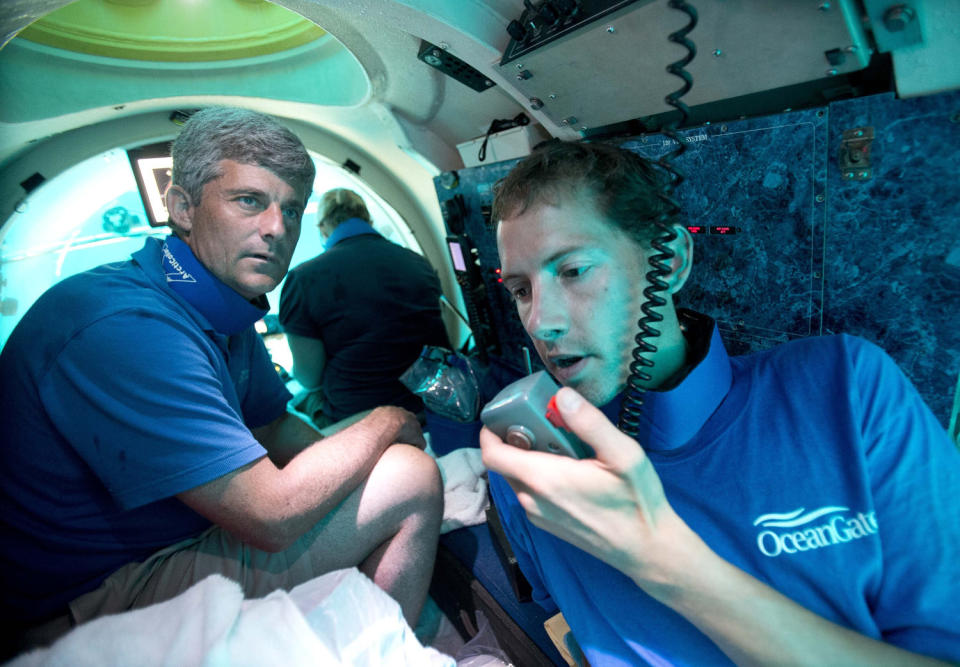To get a working submarine to the Titanic wreck site as quickly as possible, the Titan was built at the cost of safety. CEO Stockton Rush authorized cost-cutting measures and shoddy engineering, a former employee told a U.S. Coast Guard hearing Tuesday in sharp language.
“There was a lot of pressure to get this done. There were a lot of steps skipped along the way,” said David Lochridge, former director of marine operations for OceanGate, the Washington state company that operated the deep-water vessel Titan.
“The whole idea of the company was to make money,” said Lochridge, who was fired after about two years. “There was very little in the way of science.”
Rush was piloting the Titan with four others aboard, some of them paying passengers, when it imploded on the floor of the North Atlantic Ocean in June 2023 during a dive of the Titanic. All five were killed, including a famed Titanic explorer and a father and his 19-year-old son.

Fifteen months after the fatal voyage, the Coast Guard’s Marine Board of Investigation is holding a two-week hearing in South Carolina to determine what led to the disaster and what safety recommendations can be made to federal and international regulators. Possible criminal charges could also be referred to the Justice Department.
Lochridge was appointed chief operating officer in January 2016 after moving with his family from their native Scotland on a work visa OceanGate helped arrange. He testified that he was not directly involved in the design or construction of the Titan’s original hull, as his relationship with Rush had broken down in the summer of 2016 after Lochridge said he “embarrassed” his boss following a heated confrontation during a reconnaissance mission to view the sunken ocean liner Andrea Doria.
But Rush let him inspect the Titan anyway, as it was nearing completion in early 2018, Lochridge said.
What he found was “an abomination of a submarine,” he said, and he would later learn firsthand that many of the same materials had been “reused” in a second Titan hull that was produced and ultimately involved in last year’s disaster.
“Stockton liked to do things cheap,” Lochridge testified.


Lochridge was fired in January 2018 for raising concerns and acting “against the project,” he said.
His public comments on the second day of the Coast Guard hearing came after federal investigators began rolling out new details about the implosion on Monday, including a photo of the Titan’s tail cone and testimony from another top OceanGate executive, former chief engineering officer Tony Nissen.
Nissen, who was hired in 2016, said he raised concerns with Rush after Titan’s original hull — made of experimental carbon fiber, which has not been proven to withstand the pressures of the deep sea repeatedly — was compromised after it was struck by lightning during a test mission in 2018. The hull also suffered an irreparable crack, Nissen said, and he refused to approve another test mission the following year, leading to his resignation.
Lochridge said Tuesday that he had also clashed with Nissen, indicating how OceanGate has struggled internally in its efforts to win customers: convincing wealthy people to pay tens of thousands of dollars to go deep-sea diving in its submarines.
“It was all smoke and mirrors,” Lochridge said. “All the social media you see about all these previous expeditions, they always had issues with their expeditions.”
CEO ‘hit’ me on the head during diving mission
Lochridge recounted an earlier dangerous dive in the summer of 2016, when Rush piloted another of the company’s submarines, the Cyclops 1, on a trip to view the Andrea Doria, the Italian ocean liner that sank off the coast of Massachusetts in 1956 after colliding with another ship.
Lochridge testified Tuesday that he told Rush he shouldn’t be in charge of that voyage, but the CEO remained adamant. (The submarine had already attracted attention when it was unveiled the year before because it could be controlled with a PlayStation controller.)
According to Lochridge, Rush testified that during that voyage, with three paying customers aboard the Cyclops 1, Rush operated the ship in a reckless manner.
“’Don’t tell me what to do,’” Rush said, according to Lochridge.
Rush then directed the submarine directly toward the rotting ocean liner.
“He decided to head straight for the wreck,” Lochridge said, adding, “He hit the bottom” and “basically drove the ship at full speed.”
“Every time I tried to take the controller away from him, he just pushed it further and further,” Lochridge said.
According to Lochridge, one of the passengers was in tears. Rush only gave up control when a passenger started screaming.
Rush was upset and threw the PlayStation controller at me, “hitting me on the side of the head,” Lochridge said.
Eventually, Lochridge said, he retrieved the controller, which had a loose button, and repaired it before sending the Cyclops 1, which had suffered some damage, back up.
Once they were safe, the passengers cheered Lochridge, he said.
“I embarrassed him in front of clients. He was not happy,” Lochridge said of Rush. “I knew this was a turning point in our relationship.”
After Lochridge was fired, he was sued by OceanGate in 2018 for breach of contract. Among other things, the company alleged that it violated the terms of his employment contract by discussing confidential information with other employees and representatives of the Occupational Safety and Health Administration.
Lochridge filed a counterclaim against OceanGate. The two parties later settled their dispute out of court.
Lochridge explained Tuesday that instead of paying money to OceanGate as part of a settlement, he signed a nondisclosure agreement, which prevented him from speaking publicly about his employment until the Coast Guard subpoenaed him.
Filing a counterclaim “went nowhere,” Lochridge said, and he and his wife realized “it just hurt us more.”
This article was originally published on NBCNews.com